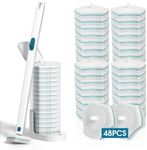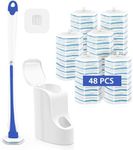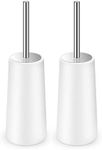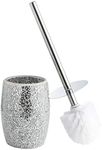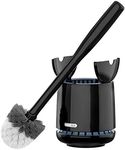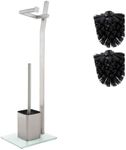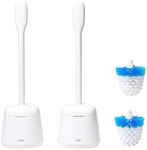Buying Guide for the Best Toilet Brushes
Choosing the right toilet brush might seem simple, but a good one can make cleaning easier, more hygienic, and even help your bathroom look tidier. When shopping for a toilet brush, it's important to consider how easy it is to use, how well it cleans, how long it lasts, and how it fits into your bathroom space. By understanding the key features, you can pick a brush that matches your cleaning habits and keeps your bathroom fresh.Bristle MaterialThe bristle material is what actually scrubs your toilet, so it's important for both cleaning power and durability. Most toilet brushes use either plastic, silicone, or natural fibers. Plastic bristles are common and offer firm scrubbing, but can wear out over time. Silicone bristles are softer, resist bacteria, and are easier to clean, but may not scrub as aggressively. Natural fibers are less common and can be less durable. If you want a brush that lasts longer and is easy to keep clean, silicone is a good choice. If you prefer a firmer scrub, plastic might be better. Think about how often you clean and how tough your stains are to decide which material suits you.
Handle Length and ComfortThe handle is what you hold while cleaning, so its length and comfort matter for ease of use. Short handles can make it harder to reach all areas and may get your hands too close to the toilet, while longer handles offer better reach and keep your hands further away from messes. Some handles are ergonomically shaped or have non-slip grips, making them more comfortable to use, especially if you clean often. If you have a small bathroom, a shorter handle might save space, but for most people, a longer, comfortable handle is more practical and hygienic.
Holder DesignThe holder is where the brush sits when not in use, and it affects both hygiene and appearance. Some holders are fully enclosed, hiding the brush and containing drips, which helps keep your bathroom looking neat and prevents odors. Others are more open, allowing the brush to dry faster but exposing it to view. Some holders have ventilation or drip trays to help with drying and cleanliness. If you want a tidy look and less odor, choose an enclosed holder with good ventilation. If quick drying is your priority, an open design might be better.
Brush Head ShapeThe shape of the brush head determines how well you can clean different parts of the toilet. Round heads are common and good for general cleaning, while angled or curved heads can reach under the rim and into tight spots more easily. Some brushes have replaceable heads, which can be more hygienic and cost-effective over time. If your toilet has tricky spots or you want a more thorough clean, look for a brush with an angled or specially shaped head. For basic cleaning, a standard round head will do the job.
Ease of Cleaning and MaintenanceA toilet brush should be easy to clean itself, so it doesn't become a source of germs. Some brushes are designed to resist dirt and bacteria, especially those with silicone bristles. Others can be rinsed easily or even have replaceable heads. If you want to minimize germs and odors, look for a brush that is easy to rinse and dries quickly, or one with antimicrobial features. If you prefer to replace the brush regularly, consider models with replaceable heads.




